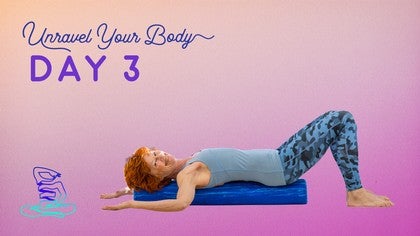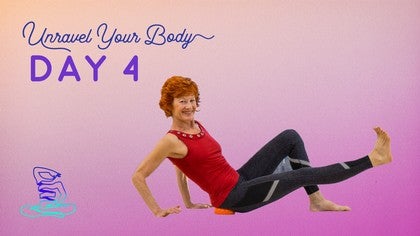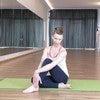Description
About This Video
Transcript
Read Full Transcript
Welcome today three. This is a real fun day because we deal with the chest and the shoulders. We all hold tension in our shoulders. For some of US shoulders hike up, the rib cage starts to get tight, so it's a very, very delightful, wonderful transformative process to open up. Before we start, we'll do the retest. The pretest, sorry, so lying on your backs just checked the your floating ribs. Are you ribs in touch with the mat? Hopefully they are, or are they up?
Just notice that. Notice how much of your rib cages touching and then lift your arms up to the ceiling and take them over your head. Now, ideally you should feel like a ragdoll when you do it. You're not trying to organize yourself and be super technical and politically correct. You just tried to test the range of movement and notice if your rib cages lifting and lowering of course. Are Your arms actually getting to the floor? For a lot of people, they're not because there's a lot of tightness there.
If your rib cage is going up and down, we know that there's tension, but just the whole thing is checking in, checking in with you, what can you do today? The other one is with your arms above your shoulders, taking them to the side. Do they go to the floor easily? And also as always, how much of your rib cages moving when you do this movement and then what I call angel arms with the nails touching the mat, you just slide your hands on the floor and you see if they go all the way above your head or not. For some people they can maybe go to here and then they come up or you have a dis change in the spinal column in order to facilitate the movement. So just check, just be very relaxed, very heavy. Don't try and control your body with your thought process or with your technique. Just see what happens with the joints.
When I move like a kid who never knew any better, so remember what it felt like because we will do a retest. Okay. So I'm working with a foam roller for this segment. This specific foam roller is a little bit softer, which I highly recommend but not essential. You can do it on any foam roller you've got the long ones are the best. So I'm sitting as far to the front of the foam roller as I possibly can get and then layering myself down on the mat, hopefully with the foam roller tracking along the my spine.
And um, if your head, this is what often happens ahead is almost at the edge, you need that head nicely supported. And just take a moment now to feel how gravity is helping to open your shoulders. You're not using any muscular control. In fact, quite the reverse. See if you can just let the shoulders release and relax down and maybe at the beginning we'll start with the elbows down so that you're balanced. Check that your feet are about hip width apart and just kind of settle into the sensation. How much can you let the soldiers open without doing anything? And now roll your head to the right.
Let it fall. It's completely heavy. And I'm taking my left hand and starting to sly the fingers as far away towards my foot as I can. So there's a deep stretch along the side of the neck and then I'm relaxing the left elbow, bringing the head up, rolling the head the other way. It's like a wheel that's turning on the road so I'm not sliding it. And then I'm taking this hand and stretching it as far away as I can opening up the whole side of the neck. So no muscles here.
It's like I'm a Ragdoll, I'm stretching the tissue so I'm lengthening the line of the bones and whatever's getting in the way from the bones going along is being communicated with and kind of restoring a sense of relaxed, [inaudible] relaxing, coming up. And one more time rolling. And this time I'm rolling the foam roller a little bit away just to have a slightly different sensation of stretch coming up. Head goes the other way. Very heavy. Rolling the hips and the shoulders in the opposite direction.
A little bit more subtle, but still a lovely stretch on the side of the body. Sometimes you'll notice that one side is very different from the other. We want to find the differences. Now this next one, I'm actually lifting my head slightly and bringing my ear in line with my spine. So instead of rolling my head, I've s adjusted the scouts, I'm still turning to the side still within as shoulders wide and long. And then the left hand stretches away ferry, slight rocking sensation side to side to start to loosen up all these muscles in the upper chest and in the neck, bringing the head backs. And now it's straight and again slightly lifting it.
So the leg, the back of the skull is moving as well as the front of the skull and the shape of the head is rotated a bit on. So it's still pivotal on the center of the spine, relaxing the shoulders, taking the right arm, stretching it as you stretch, check that you're not letting the soldier go up. You want it still heavy and long. So you're actually creating lengths from a very broad place and then coming back with the head, coming back with the arms. Now the shoulders are wide and I'm lifting my arms up to the ceiling, pumps facing each other, pulling the shoulders as far up to the ceiling, letting them drop as far up as they can go.
This is not a muscular actions. I don't want you to use your muscles. I want you to find the bones and feel the heaviness of the bones so the tissue can start to get lubricated and the ball in the socket will start to get more relaxed as well as the shoulder blades. Just being able to move away from the spine and towards the spine. Now hands come up and I'm taking my arms as far over my head as they will go.
If your ribs are coming up, let them come up, let them do whatever they can and maybe you don't even get to the mat, it doesn't matter. And then bring the hands up and take them down long fingers, shoulders wide. So start very consciously in a very heavy way to move up and down with these arms. Finding the range of movement that you can do and trusting that the movement is going to open your body up. You don't really need to do anything. Just let the tissue start to stretch. As you're doing this, it should feel good. Now for very stiff people type people.
Maybe I put a book here. Sometimes I just put people on the floor and have them do it because it's too extreme to be up on a foam roller. There's also foam rollers on the market that are have foam roller that I found very helpful as a progression when people are very tight in the shoulders, in the rib cage. The beauty of this work is the body loosens up really, really fast. So if this is something that you feel you need, if you did it for a few days in a row, you may be very surprised how much more open you are as you do this.
So now we'll start to take the arms up and let the shoulders be heavy. So if you notice I'm not squeezing my shoulder blades together, I'm just letting the bones drop to the side and now I'm taking my arms back, keeping that alignment and I can feel the openness in the armpit itself. So it's starting to address a tissue of the armpit, which is very crucial for releasing and restoring full range of movement in the arm and also for the ribcage integrity. A lot of times we're pretty locked up in the armpit and then our rib cages tight, our soldiers are tight and a range of movement is more limited, so very heavy shoulders, very relaxed and checked to see by. Now if you can do this movement without the rib cage changing shape so that you can isolate into all this tissue that's right, running down the side, you're elongating your lads, you're elongating all the connections right here into the arm armpit and you're starting to release tension in the shoulders, heavy, heavy, arms and down.
Now same thing going sideways. You want the arm bones heavy and then take the arms as far to the side. If you get to the floor, good for you. And just widen and you may feel a delicious stretch across the chest. Bring the arms up again. Heavy arm bones.
Don't use muscle. Feel that you're, you're like a ragdoll sinking. Check that the arms are right to the side. There's a natural tendency to be in a why you want t shape so the hand should be in line with your own shoulders.
Very different quality stretch.
The first time they had no idea they had so much tension in the forearm and restricted movement in the palm of the hand. It's fantastic to get the computers out of your body. I call this whole routine. Let's get the computer out of the human body and restore it to humanness, but it can be like, oh my God, I had no idea. And up, and this also is a factor in why our shoulders get tight because actually from the elbow to the wrist and the hands, everything stayed. Okay, shake your hands out because it's quite fatiguing. This whole segment. And then place your hands on the floor and you want your shoulders right so the fingers are resting, the shoulders are wide and you want to feel the floor under your nails.
Start tracking your hands, tracking them on the floor, and then keep going. And you go as far as you can. If right here, you feel your hands are coming off the floor, that's your first stop. Bring them back. Now the big thing to notice is this external rotation of the upper arm. Very, very important. That's really what you're working on. And then see if can go a little further. And if you're off the floor, doesn't matter, just keep going.
It's called windshield wipers. If you can get to the floor, great. If you can't, you bring your hands down a bit. You get to where you can get on the floor. Sometimes when people start, they actually need to be on the floor and then you flop your hands up so you externally rotate in the join. You flop your hands down. So just let the heaviness of your bones move the joint. This is not about muscles. I've been asked if I could use hold weights to stretch more. No, do not use anything. Don't force it.
Your body will adapt to the requirement and you will restore full range of movement of the joint by releasing the tension, not by pushing anything. Just trust the process and down. And then to finish, you want to with care roll off the foam roller. Let yourself just for a minute, lie down. If you knees with and just see what do you feel like, how much of your back is on the floor, your palms are up, how much of your shoulders are on the floor? They may be consider, you might maybe touching the the floor much wider, much flatter than you were before. Enjoy the feeling.
I'm preparing you because we are going to go inside the arm pit and there's a lot of tension and the actually there's calcifications that can build up, but again, once you loosen this area up and restore the range of movement of the bone in the socket, the relief and power that can come back is very anti-aging. I have no other way to say it. So what will the journey be? Your have this ball under the collarbone and we'll move out with it. The idea is that you're taking all this tissue and widening it. Then there'll be a, you'll roll onto your side and then roll the ball onto the shoulder blade on the back and then roll back with the arm coming out to the side and back.
I'll be doing this on my stomach. I just wanted you to see what is going on. So starting out, I'm placing the ball right below the left collarbone and pressing into it. Sometimes I have my forehead resting here and very slowly I'm rolling out to the left. So I'm rolling to the right. This is my left hand and if I was on the floor I would be tractioning this hand as far as I can and the ball has now locked into my deltoid. It's actually cutting this tissue and pulling on it.
And then from here I'm starting to roll onto my side. I'm walking the hand if there was for heavy walking, this hand on the floor and I'm rolling through the armpit. Very painful for some people the first time. And then I am rolling onto my back and moving the hand out. So it's taking my shoulder blade and pushing it towards a spinal column.
Now reversed walking the hand back out, moving through the tissue right under the armpit, keeping this arm as long as I can. And then I walk the hand too. It's grabbing the tissue of the armpit, moving it out to the side, and then I roll back with the ball to the sternum. So intense life changing, I hope. Okay. So I'm now moving the ball over to my right side. So it's under, you know, there's this notch and it's right under the collarbone on the right side. I'm grabbing the tissue or the skin and I'm pulling them the tissue down a little bit so it's literally kind of giving stimulation on my collarbone to move down, pressing into the ball and starting here.
Let me move over here. Starting to roll to the right. This is like grant work. You could say I am and my right hand is stretched way out away from me as though someone's grabbing my wrist and pulling it. I've now gotten a point where it's traction. The deltoid muscle on my right side, the balls hooked it and is holding it.
Now this is a hugely powerful place because as I start to rotate, the ball is not letting the deltoid muscle curl into the chest so you can spend time right in this position, opening up all this tissue. It's a fantastic place and then I'm starting to walk my hand. If I was on the floor, I would be creepy crawling the hand to bring it to the side so the ball is right under my armpit. There can be a lot of tight locked up tissue there. Take my time walking through onto my back. Now the ball is on my shoulder blade.
I've taken the arm out to the side, can hold my head or drop it down and now I start to creep and crawl back. So any places tense, you like nap, you sinking, like not sinking. Every time you revisit these exercises, your body will be softer, more malleable, and easier to go through. So here I am, I am bringing my hand back to the side. The balls move just in front of the deltoid and now I'm rolling through, back towards my sternum with pressure into the ball. Take the ball out and just for a minute, lying down, relaxing the shoulders, just seeing what I feel like.
So we've finished the shoulder routine. Let's retest and see what happened. The most fun part of all. So on your backs again, first of all, just see what's it feel like to lie on your back. How are your shoulders? How's your rib cage? How's your lower back, even though we didn't address it? And then lift the arms up and take them over your head.
And do they feel different? Are they moving differently? Can you get them more easily to the floor? Same thing going to the side. What's it feel like to take your arms out? What your tissue feel like, what your chest feel like? I hope really different. May you never be the same again.
And then angel arms, just taking the arms over your head and bringing them down again. This is just a retest for you to see how much you've changed, adapted and enjoy being on the floor. And you know, we all carry the weight of the world on our shoulders. Hopefully you just told the world to get off so you could feel great. Thank you.
Unravel Your Body Challenge: with Niedra Gabriel
Comments
I generally spend a bit of time on the floor at night, giving attention to different areas that are tight, and have gotten my husband to do this as well. So now I think we will be spending a whole hour on the floor at night, working every aspect, instead of piecemeal.
I can’t say enough how happy I am to have a whole body program! Thanks!
You need to be a subscriber to post a comment.
Please Log In or Create an Account to start your free trial.










































